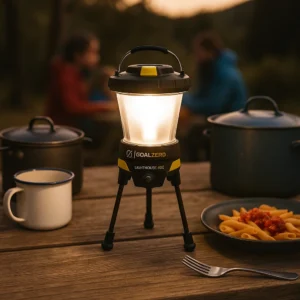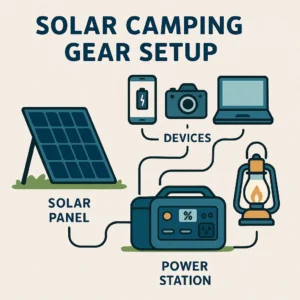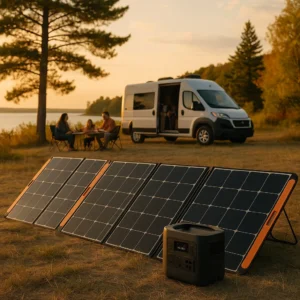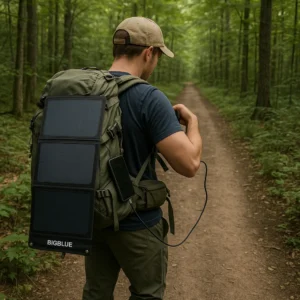Essential Solar Camping Gear 2025—Field-Tested Off-Grid Power Solutions Including Portable Solar Panels, Solar Lanterns, Phone Chargers & Lighting Equipment That Keeps You Powered Anywhere Without Generators.
TESTED Updated November 2025
After field-testing dozens of products across Michigan’s wilderness, we’ve identified the solar camping gear that actually delivers reliable off-grid power.
This guide cuts through the marketing hype to show you the best portable solar panels, solar lanterns, and charging solutions for 2025—whether you’re a backpacker, car camper, or RVer.
Gone are the days of noisy generators and dead batteries. Modern solar gear provides silent, sustainable power to keep your phones, lights, and essential devices running anywhere.
🚀 Our Top Solar Camping Gear Picks at a Glance
- Best Overall Solar Panel: Jackery SolarSaga 100W
- Best Solar Lantern: BioLite Luci Charge 360
- Best for Backpacking: BigBlue SolarPowa 28W
- Best Budget Lantern: Goal Zero Lighthouse 600
- Best Waterproof Panel: EcoFlow 110W Portable
☀️ Why Solar Camping Gear Dominates 2025: Performance & Cost Advantages
The Real Benefits of Solar-Powered Camping
Solar camping equipment eliminates the noise, fumes, and fuel costs associated with gas generators while providing sustainable power that recharges daily.
Modern solar technology has achieved efficiency levels that make renewable camping power practical—today’s panels and batteries actually deliver usable energy.
- Silent Operation: Solar systems charge batteries quietly without generator noise.
- Zero Fuel Costs: After initial purchase, solar energy remains free—no gas runs or propane refills.
- Maintenance-Free: Quality solar panels operate 25+ years with zero maintenance beyond occasional cleaning.
- Emission-Free: Solar charging produces no carbon monoxide risks in tents or enclosed spaces.
Solar Power Capacity You Actually Need
Understanding watt-hours prevents buying underpowered systems that frustrate rather than enable camping adventures.
- Phone Charging: 10-20Wh per charge—small solar panels handle smartphones easily.
- Laptop & Cameras: 50-100Wh per charge—requires 100W+ panels with power stations.
- Lights & Fans: Solar lanterns provide lighting without external power systems.
- Refrigeration: Electric coolers demand 500Wh+ stations with 200W+ solar charging.
⚙️ Our Testing Methodology: Real-World Michigan Field Conditions
At Outdoor Tech Lab, we test solar camping gear through actual field conditions across Michigan’s varied terrain—from Sleeping Bear Dunes to Upper Peninsula wilderness.
Our testing evaluates solar equipment across sunny and cloudy days, temperature extremes, and real-world scenarios where inferior products fail.
- Solar Panel Testing: We measure actual wattage output in full sun versus cloudy conditions to verify efficiency claims.
- Charging Speed: Power stations charge devices from dead to full while timing real-world cycles versus advertised rates.
- Lantern Runtime: Solar lanterns run through complete discharge cycles to confirm actual battery capacity.
- Durability: Equipment faces rain, dust, and temperature swings that reveal which products maintain functionality.
- Portability: Weight, packed size, and carry systems determine which gear works for backpacking versus only car camping.
- Value Analysis: We compare performance per dollar to identify genuine value versus overpriced marketing hype.
🎬 See Our Field Testing in Action
Real-World Testing Demo: This is exactly how we test gear—quick setup in actual camp conditions and water resistance verification. See our methodology come to life before we get to the product recommendations.
🏆 Essential Solar Camping Gear for 2025
These solar products represent the core power and lighting equipment you need for self-sufficient camping across diverse outdoor environments.
| Product Category | Best Model | Rating | Key Feature | Best For | Price Range |
|---|---|---|---|---|---|
| Portable Solar Panel | Jackery SolarSaga 100W | 4.7/5 ⭐ | 23% Efficiency | Power Station Charging | $200-300 |
| Solar Lantern | BioLite Luci Charge 360 | 4.6/5 ⭐ | 360 Lumens + Phone Charger | Camp Lighting | $50-70 |
| Budget Solar Lantern | Goal Zero Lighthouse 600 | 4.6/5 ⭐ | 600 Lumens Compact | Versatile Lighting | Under $60 |
| Solar Phone Charger | BigBlue SolarPowa 28W | 4.5/5 ⭐ | Dual USB Ports | Backpacking | Under $90 |
| Compact Solar Panel | EcoFlow 110W Portable | 4.7/5 ⭐ | IP68 Waterproof | Weekend Trips | $150-250 |
| Ultralight Solar | BioLite SolarPanel 5+ | 4.4/5 ⭐ | Integrated Battery | Thru-Hiking | $70-90 |
| String Lights | BioLite Luci Solar String | 4.5/5 ⭐ | 44ft Coverage | Camp Ambiance | $60-80 |
Jackery SolarSaga 100W Portable Solar Panel
Best Overall Portable Solar Panel for Camping
✅ Pros
- High 23% solar efficiency
- Lightweight at under 8 lbs
- Multiple USB and DC ports
- Built-in kickstand legs
❌ Cons
- Larger footprint when folded
- Not fully waterproof (IP65)
- No cable storage pouch
The Jackery SolarSaga 100W delivers proven solar charging performance that sets the standard for portable solar panels, representing our top pick for campers who need reliable off-grid power.
This panel achieves 23% solar conversion efficiency through monocrystalline technology, outperforming competitors at similar price points.
Lightweight construction makes the SolarSaga practical for car camping where heavier panels become burdensome.
Built-in kickstand legs deploy quickly to angle the panel toward the sun, maximizing charging efficiency during morning and evening hours.
USB-A, USB-C, and DC output ports enable direct device charging or power station connection without additional adapters.
Pairs perfectly with systems in our portable power station guide and Jackery vs Goal Zero comparison.
Check Latest Price & Availability
BioLite Luci Charge 360 Solar Lantern
Best Solar Lantern with Phone Charging
✅ Pros
- 360 lumens brightness
- 4,000mAh phone charging
- Collapses to 1.5 inches
- IP67 waterproof rating
❌ Cons
- Shorter runtime on high
- Slow solar recharge time
- Higher price than basic lanterns
The BioLite Luci Charge 360 solar camping lantern provides exceptional lighting and phone charging in a collapsible package.
Delivers 360 lumens—sufficient to illuminate entire picnic tables for meal prep after dark.
4,000mAh internal battery charges smartphones while providing hours of campsite lighting.
Inflatable design collapses to 1.5 inches, saving pack space versus rigid lanterns.
Integrated solar panel recharges during daylight, enabling multi-day trips without external power.
Waterproof construction withstands rain in camping environments where weather changes rapidly.
Check Latest Price & Availability
Goal Zero Lighthouse 600 Lantern
Best Budget Solar-Compatible Lantern
✅ Pros
- Powerful 600 lumen output
- Hand-crank backup charging
- Dual-directional lighting
- 5200mAh phone charging
❌ Cons
- No built-in solar panel
- No IPX waterproof rating
- Heavier than inflatable options
Goal Zero Lighthouse 600 provides exceptional brightness backed by extensive outdoor testing.
600-lumen output illuminates large camping areas for group sites.
Rechargeable battery enables solar integration via power station connection.
Hand-crank emergency charging provides backup when batteries deplete—one minute of cranking delivers 10 minutes of light.
Dual-directional lighting aims brightness where needed versus illuminating all directions.
Integrates with our solar generator guide for extended off-grid capability.
Check Latest Price & Availability
BigBlue SolarPowa 28W Solar Charger
Best Solar Phone Charger for Backpacking
✅ Pros
- 28W fast phone charging
- Dual USB ports
- Built-in ammeter display
- Under $90 price point
❌ Cons
- Not fully waterproof
- No integrated battery
- Larger when packed vs mini panels
BigBlue SolarPowa 28W delivers reliable phone charging for backpackers who can’t carry heavy power stations.
28-watt output charges smartphones in 2-3 hours of direct sunlight.
Dual USB ports enable simultaneous two-device charging.
Four-panel fold design packs to backpack-friendly dimensions.
Built-in ammeter displays charging rate for optimization.
Weather-resistant construction withstands brief rain exposure.
Check Latest Price & Availability
EcoFlow 110W Portable Solar Panel
Best Waterproof Solar Panel
✅ Pros
- IP68 fully waterproof
- 110W optimal capacity
- Lightweight construction
- Adjustable kickstand
❌ Cons
- Higher price point
- Limited to EcoFlow ecosystem
- Smaller than 200W options
EcoFlow 110W achieves rare IP68 waterproof rating enabling worry-free setup during unpredictable weather.
Can be left deployed during day hikes without rushing back when clouds appear.
110-watt capacity balances portability and power for weekend camping.
Lightweight construction suits motorcycle camping and kayak trips.
Adjustable kickstand enables sun angle optimization throughout the day.
Check Latest Price & Availability
BioLite SolarPanel 5+ Power Bank
Best Ultralight Solar Charger for Thru-Hiking
✅ Pros
- Under 14 ounces weight
- Integrated 3,200mAh battery
- Built-in sundial feature
- Heat-dissipating design
❌ Cons
- Low 5W output
- Slow charging speed
- Higher price per watt
BioLite SolarPanel 5+ combines panel and battery in an ultralight package for thru-hikers.
Built-in 3,200mAh battery stores solar energy for after-dark phone charging.
Unique sundial helps angle panel optimally without guessing.
Integrated kickstand clicks into position for tool-free adjustment.
Ruggedized construction dissipates heat effectively during sustained sun exposure.
Integrates with our off-grid camping tech guide.
Check Latest Price & Availability
BioLite Luci 44ft Solar String Lights
Best Solar String Lights for Camp Ambiance
✅ Pros
- 44-foot coverage area
- Detachable power hub
- Tangle-resistant cord
- 16+ hour runtime
❌ Cons
- Not essential gear
- Limited to ambiance lighting
- Requires tree/post setup
BioLite Luci Solar String Lights transform campsites into welcoming spaces through distributed lighting.
44-foot strand with 20 LED nodes covers large camping areas.
Detachable power hub enables solar recharging without removing lights from branches.
Durable nylon cord resists tangling during storage and setup.
Solar charging provides 16+ hours runtime after full-day sun exposure.
Check Latest Price & Availability
📋 Complete Solar Camping Checklist 2025: Build Your Power System
Building a functional solar camping system requires strategic component selection based on power needs, camping style, and budget constraints.
Essential Solar Power Components
- Portable Solar Panel: 100W minimum for meaningful power station charging—smaller panels work only for direct phone charging
- Power Station or Battery: Capacity matched to daily energy consumption—see our portable power station comparison
- Solar Lantern: Self-contained lighting eliminates reliance on power station battery for basic illumination needs
- Phone Charger: Dedicated solar phone charger for backpacking trips where power stations add excessive weight
- Charging Cables: USB-C, USB-A, and device-specific cables in waterproof storage bag
- Extension Cables: Long DC cables enable panel placement in sun while equipment remains in shade
Solar System Setup by Camping Style
- Backpacking System: BioLite SolarPanel 5+ or BigBlue 28W charger plus small power bank for ultralight power
- Car Camping System: Jackery SolarSaga 100W panel paired with 300-500Wh power station for weekend trips
- RV/Overlanding System: Multiple 100W+ panels feeding 1000Wh+ power station for extended off-grid living
- Emergency Preparedness: Solar generator combo with panels, power station (Jackery 1000 V2), and lanterns for multi-day power outages
- Festival/Event Camping: Solar lanterns and phone chargers for lighting and communication without generator noise
Daily Solar Charging Routine
- Morning Setup: Deploy solar panels facing south at optimal angle as soon as sun rises above treeline
- Midday Adjustment: Reposition panels every 2-3 hours to track sun movement for maximum charging efficiency
- Afternoon Priorities: Charge power stations and lantern batteries first, then top off phones and accessories
- Evening Storage: Bring panels inside tent or vehicle to prevent moisture damage and morning condensation
- Weather Monitoring: Check forecast and charge equipment fully before multi-day cloudy periods
💡 Pro Tip: Solar Panel Angle Optimization
For maximum solar charging efficiency, angle your panels perpendicular to the sun’s rays—approximately 30-45 degrees in summer, 60-70 degrees in winter at Michigan latitudes.
A simple trick: adjust panel angle until your shadow is shortest at solar noon (around 1pm daylight time), then lock kickstands in position for peak charging performance.
Frequently Asked Questions About Solar Camping Gear
What do I need for solar power camping?
Essential solar camping gear includes a portable solar panel (100W minimum), portable power station (300-1000Wh capacity), solar lantern for lighting, and charging cables. Weekend campers start with a 100W solar panel paired with a 300Wh power station to charge phones, lights, and small electronics. Add solar lanterns for lighting independence and backup phone chargers for redundancy. Extended trips or RV camping require larger 200W+ panels with 1000Wh+ power stations to run refrigerators and laptops.
Will a 200W solar panel run a 12V fridge?
Yes, a 200W solar panel can run a 12V camping fridge, but you need a portable power station as a battery buffer. Most 12V fridges consume 40-60 watts continuously, using 500-800Wh daily. A 200W panel generates 800-1000Wh on sunny days, enough to run the fridge plus recharge the power station. Pair your 200W panel with at least a 500Wh power station to store excess solar energy for overnight fridge operation when panels aren’t generating power. Cloudy days may require rationing power or pre-charging batteries.
Are solar panels worth it for camping?
Solar panels are absolutely worth it for regular campers who take 10+ trips annually. A $300 solar setup eliminates ongoing battery costs, generator fuel expenses, and campground hookup fees that total $1000+ over five years. Solar panels provide silent, emission-free power that lasts 20+ years with zero maintenance. Weekend warriors and occasional campers gain freedom to camp in remote dispersed sites without electrical hookups. The investment pays for itself through eliminated fuel costs and expanded camping location options beyond developed campgrounds.
Can AC be run on solar power?
Small air conditioners can run on solar power, but require substantial equipment. Window AC units consuming 500-1500 watts need portable power stations rated 2000W+ output with 2000Wh+ battery capacity. You’ll need 400-800W of solar panels to recharge batteries during daytime operation. Most camping solar setups can’t run AC units—they’re sized for phones, lights, and small appliances. For cooling while camping, solar-powered fans consume just 5-20 watts and run easily on basic 100W solar systems with small power stations.
How much solar power do I actually need for camping?
Most weekend campers need 100-300Wh of battery capacity paired with a 100W solar panel. This setup charges 2-3 smartphones daily, runs LED lights, and powers small fans. For laptop use or electric coolers, step up to 500-1000Wh power stations with 200W+ solar panels. Backpackers can manage with just 20-40W foldable chargers for phone and GPS charging.
Will solar panels work on cloudy days?
Yes, but charging efficiency drops 50-80% compared to full sun conditions. Modern monocrystalline panels still generate usable power in overcast conditions, just at reduced rates. Plan for 2-4x longer charging times on cloudy days and prioritize essential device charging when sun conditions aren’t optimal.
How long do solar lanterns last per charge?
Quality solar lanterns like the BioLite Luci and Goal Zero Lighthouse run 4-7 hours on high brightness settings and 100+ hours on low settings. Runtime depends on brightness level, battery capacity, and LED efficiency. Most solar lanterns recharge fully in 7-10 hours of direct sunlight or 4-6 hours via USB connection.
Can I leave solar panels outside overnight?
While waterproof panels can technically remain outside, morning dew and condensation can damage electronics over time. Best practice: bring panels inside tents or vehicles each evening to prevent moisture damage, extend lifespan, and avoid theft at developed campgrounds. The few minutes of daily setup and takedown protects your investment.
What’s the difference between portable power stations and solar generators?
These terms describe the same product—rechargeable battery systems with AC/DC outlets. “Solar generator” typically means a power station sold with matching solar panels as a complete system. Both charge via solar panels, wall outlets, or car chargers. The key difference is marketing terminology rather than actual functionality.
Are solar camping products worth the investment versus traditional batteries?
For frequent campers, yes absolutely. Solar gear pays for itself after 10-20 camping trips through eliminated disposable battery costs and generator fuel. Solar panels last 20+ years with zero ongoing costs beyond initial purchase. The quiet operation, environmental benefits, and unlimited recharging capability make solar superior for regular outdoor use compared to disposable batteries or noisy generators.
How do I size a solar panel for my power station?
Match or exceed your power station’s maximum solar input rating for fastest charging. A 300Wh power station typically accepts 100-200W solar input. Larger 1000Wh+ stations handle 400W+ solar arrays. Check your power station specs for “maximum solar input” and choose panels that max out this capacity for optimal charging speed during limited sunlight hours.
⚡ Integrating Solar with Complete Power Systems
Solar panels represent just one component of comprehensive off-grid power systems that keep modern camping gear operational beyond electrical hookups.
Portable Power Station Pairing
Matching solar panels with appropriate power stations creates complete systems that charge during day and power equipment through evenings.
Our comprehensive portable power station buying guide analyzes capacity, output, and solar compatibility across leading brands.
For campers comparing major brands before purchase, our detailed Jackery vs Goal Zero vs EcoFlow comparison reveals performance differences in real-world testing.
Understanding complete solar generator systems helps optimize component selection—check our best solar generators guide for integrated panel and power station combos.
Complete Off-Grid Tech Systems
Solar power enables comprehensive camping technology systems beyond basic phone charging and lighting.
Building complete off-grid capability requires strategic equipment selection covered in our complete off-grid camping tech guide.
Solar systems integrate with satellite communicators, GPS devices, cameras, and other technology that modern outdoor adventures depend on for safety and documentation.
🌲 Best Portable Solar Panels for Camping: Panel Types Explained
Understanding different portable solar panel types helps campers choose appropriate systems for their specific outdoor activities and power requirements.
Foldable vs Rigid Solar Panels
Portable solar kits for camping come in foldable fabric designs or rigid panel construction, each with distinct advantages for different camping styles.
Foldable panels like the Jackery SolarSaga pack flat for vehicle storage and weigh less than rigid alternatives, making them ideal for car camping and occasional use.
Rigid panels offer superior durability and weather resistance but consume more storage space—better suited for permanent RV installations or base camp setups.
Self-standing solar panels with built-in kickstands enable quick deployment without additional mounting hardware that gets lost in camping gear.
Waterproof Solar Panels for Camping
Waterproof solar panels for camping rated IP67 or IP68 withstand rain and moisture exposure that destroys standard panels in outdoor environments.
The EcoFlow 110W achieves IP68 waterproof rating, enabling worry-free deployment during unpredictable weather without constant monitoring.
Water-resistant panels (IP65) handle splashes but require shelter during sustained rain—understand the difference before purchasing for wet climate camping.
Small Solar Panels for Camping
Small solar panels for camping in the 20-40W range work specifically for backpacking where weight matters more than charging speed.
The BigBlue 28W represents optimal balance between portability and power generation for phone and GPS charging during multi-day backcountry trips.
Ultra-compact panels under 20W charge devices slowly but pack into daypack side pockets for emergency power during unexpected situations.
⚡ Solar-Powered Gadgets for Camping Beyond Basic Charging
Solar-powered gadgets for camping extend beyond panels and lanterns to include specialized equipment that enhances outdoor experiences through renewable energy.
Complete Portable Solar Systems for Camping
Portable solar systems for camping combine panels, batteries, and charging infrastructure in integrated packages designed for specific outdoor applications.
- Solar Showers: Portable shower bags with integrated solar heating provide warm water for hygiene during extended camping trips
- Solar Fans: Battery-powered fans with solar charging panels deliver cooling without generator noise or disposable battery waste
- Solar Water Purifiers: UV sterilization systems powered by solar panels create safe drinking water from natural sources
- Solar Bluetooth Speakers: Weatherproof speakers with solar charging enable music without draining phone batteries
- Solar Motion Lights: Automated perimeter lighting for camp security and nighttime navigation around tents and vehicles
✅ Strategic Solar Gear Acquisition Priority
Building solar camping capability requires strategic component acquisition based on immediate needs and long-term system goals.
Recommended Purchase Sequence
Phase 1 – Lighting Independence: Start with solar lanterns to eliminate reliance on disposable batteries for campsite illumination.
Phase 2 – Phone Charging: Add portable solar phone charger or small power bank for communication device charging.
Phase 3 – Expandable Power: Invest in quality portable power station matched to your typical camping power consumption.
Phase 4 – Solar Charging: Add 100W+ solar panel to recharge power station during multi-day trips.
Phase 5 – System Expansion: Grow capability with additional panels, larger power stations, or specialized equipment as needs evolve.
📊 Solar Camping Gear Investment Analysis
Understanding the true value of solar equipment requires analyzing total cost of ownership versus alternatives over multiple camping seasons.
5-Year Cost Comparison Analysis
Comparing solar systems against traditional power sources reveals long-term value beyond initial purchase price.
- Solar System (100W panel + 300Wh station): $400 initial cost + $0 ongoing = $400 total over 5 years
- Disposable Batteries: $20 per trip × 20 trips/year × 5 years = $2,000 total plus environmental waste
- Gas Generator: $300 initial + $15 fuel per trip × 100 trips + $100 maintenance = $1,900 total plus noise pollution
- Campground Hookups: $15 extra per night × 50 nights = $750 annually, $3,750 over 5 years with limited dispersed camping options
📚 Essential Resources for Solar Camping & Off-Grid Power
Beyond quality solar gear, successful off-grid camping requires knowledge about solar technology, power management, and system optimization for outdoor environments.
- U.S. Department of Energy – Solar Technologies – Government research on solar panel efficiency, technology advances, and renewable energy education for consumers.
- National Renewable Energy Laboratory – Independent testing standards and performance data for solar panel efficiency ratings and technology comparisons.
- Outdoor Tech Lab Internal Resources:
- Best Portable Power Stations 2025 – Comprehensive power station comparison covering capacity, output, and solar compatibility.
- Jackery vs Goal Zero vs EcoFlow – Head-to-head testing of leading solar generator brands in real-world conditions.
- Best Solar Generators 2025 – Complete solar generator systems with integrated panels and power stations.
- Off-Grid Camping Tech Kit Guide – Complete technology systems for self-sufficient outdoor adventures.
- Solar Safety Standards – Understanding IP ratings, voltage specifications, and safe charging practices for outdoor solar equipment in variable weather conditions.
🎯 OTL Bottom Line: Your Path to Solar-Powered Camping
Transitioning to solar camping gear is one of the most impactful upgrades you can make for modern outdoor adventures. The combination of silent operation, zero fuel costs, and total energy independence fundamentally changes where and how you can camp.
Based on our extensive field testing, starting with a core system like the Jackery SolarSaga 100W panel and a BioLite solar lantern provides the most value and immediate utility for the majority of campers.
From there, you can expand your system based on your specific power needs for backpacking, RVing, or emergency preparedness.
The initial investment pays for itself many times over through eliminated fuel and battery costs, not to mention the priceless value of camping further off the grid, more quietly, and more sustainably.
Ready to power your adventures with the sun? Use the links above to check real-time prices and availability on our top-rated solar camping gear.
- SPEED UP YOUR RECHARGEABILITY: It takes only 2 hours to recharge 80% battery of the power station through the wall outle…
- SAFE & STEADY POWER SUPPLY: Armed with a 293Wh lithium-ion battery pack, the Explorer 300 features 2 Pure Sine Wave AC o…
- POWER YOUR EXPECTATIONS: Featuring 2* AC outlet, 1* PD 60W USB-C port (input/output supported) , 1* fast charge 3.0 port…










Leave a Reply